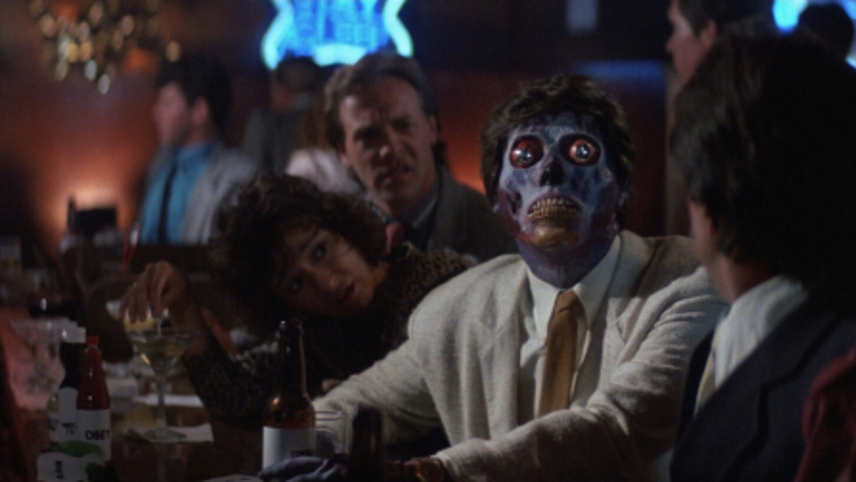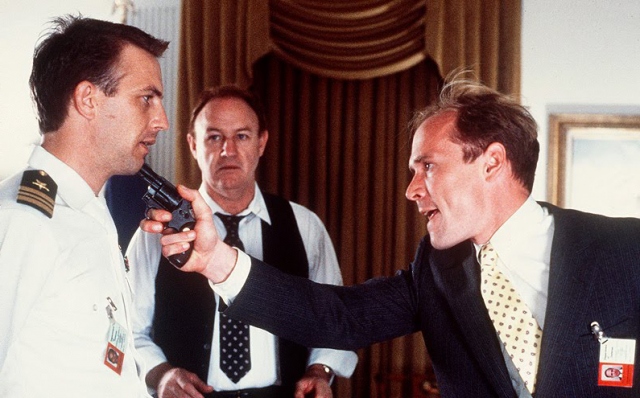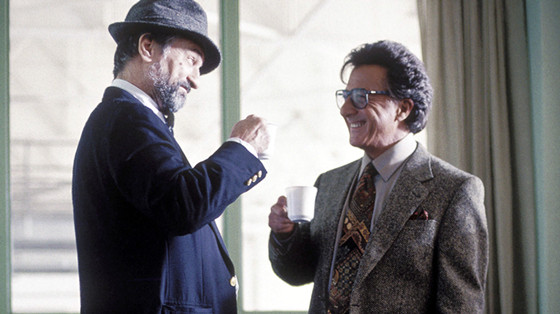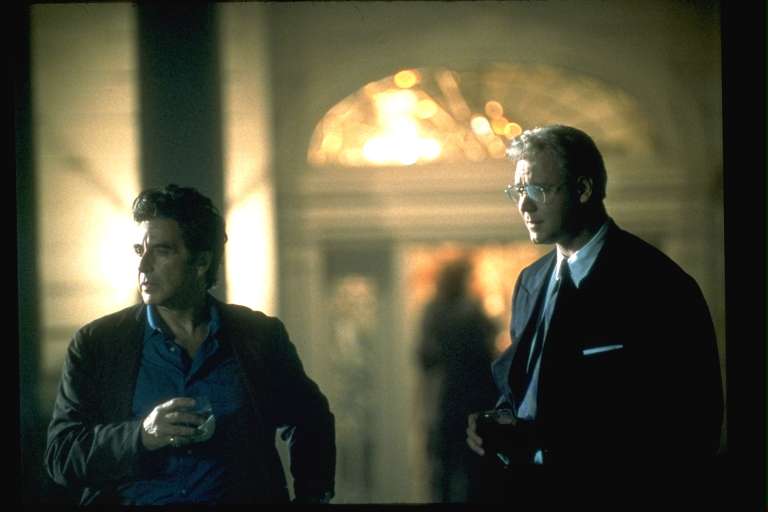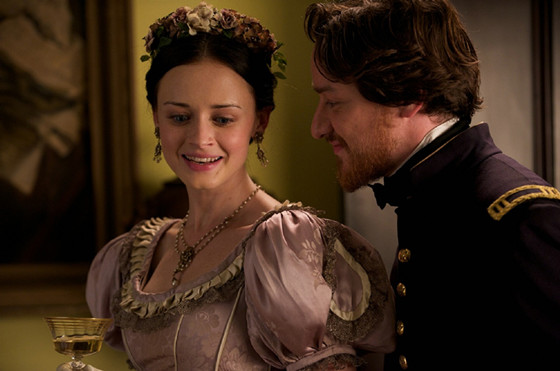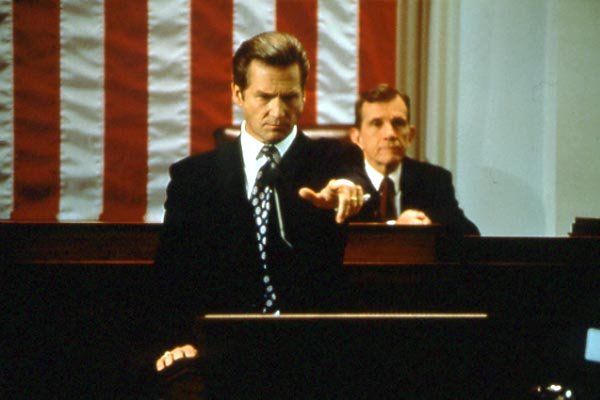14. They Live (1988)
John Carpenter’s They Live is a cult science fiction tale where an alien conspiracy has already taken over humanity and we don’t know it. Homeless drifter, Nada (Rowdy Roddy Piper), stumbles upon a box full of magic sunglasses that allow him to see the aliens disguised as humans and the secret, subliminal messages hiding everywhere that tell people to, “obey,” “submit,” “watch TV,” “stay asleep,” etc.
Some have understood the film as a general commentary on capitalist, consumerist America, while others claim it is a direct warning about whatever conspiracy they believe, “runs the world” (Jews, Illuminati, Freemasons, Trilateral Commission, Bilderbergs, Council on Foreign Relations, Lizard People, you name it). If you like campy action flix it should definitely be on your list.
15. No Way Out (1987)
This is the film that put Kevin Costner on the star map. He plays Naval Officer Tom Farrell, who works for Secretary of Defense David Brice (Gene Hackman). When Brice accidentally kills his mistress, who was also seeing Farrell, a conspiracy is hatched by the secretary’s ambitious assistant, Scott Pritchard (Will Patton) to pin the crime on an alleged Soviet spy and Farrell is put in charge of the investigation that will inevitably lead to himself.
It is a gripping thriller, with *spoiler* an even more interesting conspiracy waiting in the wings to give the movie a final, great twist ending.
16. Conspiracy Theory (1997)
Real life conspiracy theorists Mel Gibson, whose public pronouncements about, “The Jews,” have subsequently tainted his career forever, plays a conspiracy obsessed cab drive who turns out to actually be a brainwashed cog in the machinery of a vast conspiracy run by a, “secret agency that watches the other agencies.”
As usual, the number of people involved in the plot and the actions they are able to take over a long period of time without anything leaking out, along with other problems, make the production unrealistic but it is amazing how real it can feel when you are in the state of suspended disbelief that all movies require. Unfortunately, the affects of that suspended disbelief can leave the theater with you.
17. Wag the Dog (1997)
Released during Bill Clinton’s Presidency, just before his own sex scandal broke, and before he took limited military action against an alleged terrorist site abroad, Wag the Dog has felt very real to many viewers, who now use the term, “wag the dog,” for any news items they believe are deliberate distractions from the important/real news we should be paying attention to. In the movie, an unnamed President makes sexual advances on an underage woman just two weeks before the next election.
A Hollywood movie producer is brought in to manufacture a false war in Albania, which gets out of control and gets one American soldier killed. Spoiler: The soldier was a bad guy who deserved to die but he is made into a hero to make this fictional “news” sound better.
The final problem of the story is that the producer, Stanley Motss (Dustin Hoffman) wants credit for this big lie he was able to pull off and the White House advisor behind it all, Conrad Brean (Robert De Niro), can’t let Motss talk, so he has Motss murdered. Comparing the real life events of President Clinton’s improprieties with the events in Wag the Dog is another great example of the huge differences that typically exist between the real world and Hollywood’s sensationalistic representations of it.
18. The Insider (1999)
Based on the real life story of Jeffrey Wigand (Russell Crowe), a scientist who worked for the tobacco industry, The Insider has a couple interrelated conspiracies going on. First is the long-running but unsustainable conspiracy of tobacco companies to deny that cigarettes were addictive and harmful while deliberately making them more addictive and harmful.
When Wigand begins to talk to someone from the CBS news magazine, 60 Minutes (1968-), about what he knows of his former employer’s business practices, he and his family are intimidated and stressed out to the point that his wife takes their children and leaves him. Even after Wigand talks, the higher ups at 60 Minutes conspire to create an excuse to not use his interview, for fear of blowing the sale of CBS to a company in the tobacco business. In the end, however, The New York Times runs a condemnation of CBS that pushes them into showing the interview.
The film highlights the fact that there are always competing groups (e.g. other news outlet, other political parties and encampments, other branches of the government, other businesses, etc.) that will have different interests than the conspirators. There is no monolithic interest of, “The Government,” “The Bankers,” “The Ruling Class,” etc.
This or that group may conspire successfully in a limited space, where they have great influence, but the longer the conspiracy goes on the more likely it will move into a space where others have a great influence and plenty of reasons to expose what the first group has done.
19. The Conspirator (2010)
Everyone knows that John Wilkes Booth shoot and killed President Abraham Lincoln but most Americans seem to be unaware of the fact that there was a larger conspiracy involved. Two of Booth’s friends tried to murder Vice President Andrew Johnson and Secretary of State William Seward that same night, in order to cause a vacuum of leadership in the Union.
Only Booth succeeded but he was later killed when soldiers found him hiding in a barn, while his friends were put on trail for aiding in his conspiracy. There have been a couple of films – The Prisoner of Shark Island (1936), The Ordeal of Dr. Mudd (1980) – the second more accurate than the first, which argue that the doctor who set Booth’s broken leg after the assassination should not have been given such a harsh sentence.
The Conspirator is similar to these but it focuses on Mary Surratt (Robin Wright), the woman who ran the boarding house where the conspirators meet and some of them lived.
Surratt was convicted by a military tribunal as a member of the conspiracy and she is the first women ever executed by the Federal Government. The Conspirator makes it seem that her trail was a clear case of injustice and it is an analogy for the perceived injustices that the Director, Robert Redford, believes the Federal Government engaged in after 9/11.
Unfortunately, Redford chose drama over historical accuracy. He falsely shows the tribunal not allowing Surratt’s daughter to visit her in prison and inflates the problems with the case while downplaying the evidence against her. Worst of all, after allowing the defense lawyer to give a rousing closing argument about the importance of the Constitution and our Constitutional right, the film moves on to the next scene and does not even allow us to here the Prosecution’s argument.
The political left like to believe that their side is better at, “grey areas,” or, “political nuance,” but the predominately left-leaning and often heavy-handed politics in Hollywood movies seriously question that assumption.
20. The Contender (2000)
The tagline for The Contender was: “Sometimes you can assassinate a leader without firing a shot.” It is a story of character assassination, rather than murder, which directly references the history of McCarthyism and why we don’t want to repeat it in slightly different forms.
When President Jackson Evans (Jeff Bridges) nominates Senator Laine Hanson (Joan Allen) to be his new Vice President, a group of Congressmen, lead by Representative Shelly Runyon (Gary Oldman), conspire to block her through under the table tactics. They give some justifications for why they do not like her politics but it is obvious that the root of the problem is sexism.
It is a clever and compelling tale of Washington intrigue that has *spoiler* a good twist at the end. It is also a fairly good representation of the limits to which American politicians will go to extend their power. Dirty tricks? Yes. Unfair accusations? Yes. Media manipulation? Absolutely. But the lack of any murders or Mafia-like activity in this film is refreshing. It is dramatic while being far more realistic than most conspiracy films.
Funny Note: Fans of The Big Lebowski (1998) will notice that President Jackson has the same poster-sized image of President Nixon bowling on display at the White House that The Dude (Jeff Bridges) has in his crappy apartment. And Sam Elliott, who plays the helpful “Stranger” Cowboy character in The Big Lebowski also plays President Jackson’s Chief of Staff in The Contender.
Author Bio: James K. Lambert is a documentarian and professor of film who lives in Minneapolis, Minnesota. His latest film, Conspiracy Theorists Lie (2015), is now available online at http://nomagicbullets.org. For a complete filmography visit http://jamesklambert.com.
